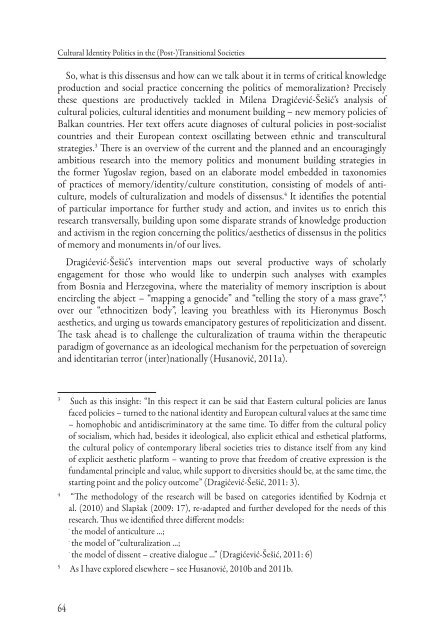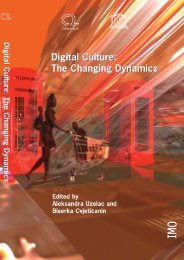free download in pdf format - Culturelink Network
free download in pdf format - Culturelink Network
free download in pdf format - Culturelink Network
Create successful ePaper yourself
Turn your PDF publications into a flip-book with our unique Google optimized e-Paper software.
Cultural Identity Politics <strong>in</strong> the (Post-)Transitional Societies<br />
So, what is this dissensus and how can we talk about it <strong>in</strong> terms of critical knowledge<br />
production and social practice concern<strong>in</strong>g the politics of memoralization? Precisely<br />
these questions are productively tackled <strong>in</strong> Milena Dragićević-Šešić’s analysis of<br />
cultural policies, cultural identities and monument build<strong>in</strong>g – new memory policies of<br />
Balkan countries. Her text off ers acute diagnoses of cultural policies <strong>in</strong> post-socialist<br />
countries and their European context oscillat<strong>in</strong>g between ethnic and transcultural<br />
strategies. 3 Th ere is an overview of the current and the planned and an encourag<strong>in</strong>gly<br />
ambitious research <strong>in</strong>to the memory politics and monument build<strong>in</strong>g strategies <strong>in</strong><br />
the former Yugoslav region, based on an elaborate model embedded <strong>in</strong> taxonomies<br />
of practices of memory/identity/culture constitution, consist<strong>in</strong>g of models of anticulture,<br />
models of culturalization and models of dissensus. 4 It identifi es the potential<br />
of particular importance for further study and action, and <strong>in</strong>vites us to enrich this<br />
research transversally, build<strong>in</strong>g upon some disparate strands of knowledge production<br />
and activism <strong>in</strong> the region concern<strong>in</strong>g the politics/aesthetics of dissensus <strong>in</strong> the politics<br />
of memory and monuments <strong>in</strong>/of our lives.<br />
Dragićević-Šešić’s <strong>in</strong>tervention maps out several productive ways of scholarly<br />
engagement for those who would like to underp<strong>in</strong> such analyses with examples<br />
from Bosnia and Herzegov<strong>in</strong>a, where the materiality of memory <strong>in</strong>scription is about<br />
encircl<strong>in</strong>g the abject – “mapp<strong>in</strong>g a genocide” and “tell<strong>in</strong>g the story of a mass grave”, 5<br />
over our “ethnocitizen body”, leav<strong>in</strong>g you breathless with its Hieronymus Bosch<br />
aesthetics, and urg<strong>in</strong>g us towards emancipatory gestures of repoliticization and dissent.<br />
Th e task ahead is to challenge the culturalization of trauma with<strong>in</strong> the therapeutic<br />
paradigm of governance as an ideological mechanism for the perpetuation of sovereign<br />
and identitarian terror (<strong>in</strong>ter)nationally (Husanović, 2011a).<br />
3 Such as this <strong>in</strong>sight: “In this respect it can be said that Eastern cultural policies are Ianus<br />
faced policies – turned to the national identity and European cultural values at the same time<br />
– homophobic and antidiscrim<strong>in</strong>atory at the same time. To diff er from the cultural policy<br />
of socialism, which had, besides it ideological, also explicit ethical and esthetical platforms,<br />
the cultural policy of contemporary liberal societies tries to distance itself from any k<strong>in</strong>d<br />
of explicit aesthetic platform – want<strong>in</strong>g to prove that <strong>free</strong>dom of creative expression is the<br />
fundamental pr<strong>in</strong>ciple and value, while support to diversities should be, at the same time, the<br />
start<strong>in</strong>g po<strong>in</strong>t and the policy outcome” (Dragićević-Šešić, 2011: 3).<br />
4 “Th e methodology of the research will be based on categories identifi ed by Kodrnja et<br />
al. (2010) and Slapšak (2009: 17), re-adapted and further developed for the needs of this<br />
research. Th us we identifi ed three diff erent models:<br />
- the model of anticulture ...;<br />
- the model of “culturalization ...;<br />
- the model of dissent – creative dialogue ...” (Dragićević-Šešić, 2011: 6)<br />
5 As I have explored elsewhere – see Husanović, 2010b and 2011b.<br />
64



